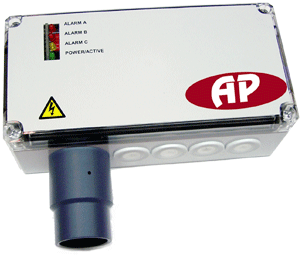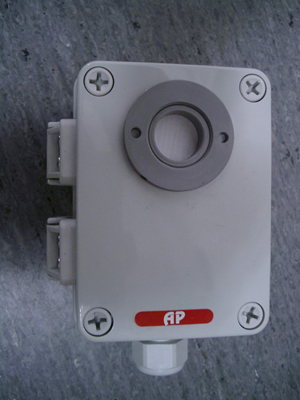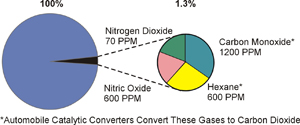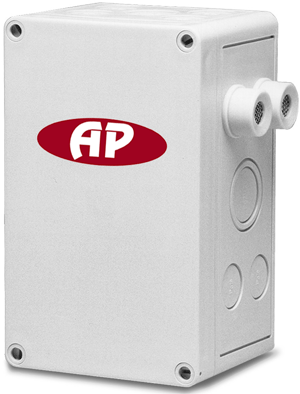|
|
|
Design tips for garage and parking houses on the
use of CO and NO2 detectors
Carbon monoxide (CO petrol)/nitrogen dioxide (NO2
Diesel)
Acceptable concentration of carbon monoxide in garages, tunnels,
etc. are governed by the overall BBR 1999 and the Swedish Construction
Standard 1980 Edition 2, 3:67.
The limit is set to 50 ppm.
Strangely enough, there are no rules in BBR 1999 or in the Swedish
Construction Standard for acceptable concentrations of nitrogen dioxide
but the rules for Exposure Limits (AFS 1996:2) are very strict.
Carbon monoxide CO has a threshhold level (a limit for exposure during
the working day for ambient air monitoring) of 35 ppm.
If the source is
exhaust fumes, the threshhold level is 20 ppm.
The
Short-term value (a recommended value, which consists of
time-related average of exposure over a reference period of 15 minutes)
is 100 ppm, except for exhaust fumes.
Nitrogen dioxide
NO2 has a threshhold level for emissions at 1 ppm, and
in cases of no exhaust fumes, 2 ppm.
Top limit where there are no exhaus fumes is
set to 5 ppm.
The Swedish building standard states that if the CO concentration
exceeds 50 ppm the fans must rotate at full speed and logically, this
should also apply to a concentration of nitrogen dioxide of 1 ppm.
Sensor Placement:
Carbon monoxide has a slightly lower density than air but is still
close to the air density that can be easily affected by draft.
It is normally said that gas with a lower density (lighter gas) rises
towards the ceiling and that you should adjust the sensor placement in
these cases, but when the gas density is very close to that of the air, it must
be taken into account that it is very easily influenced and can end up
anywhere in the room.
In these cases, the sensor is best placed at
breathing height. |
 |
|
On/off 3
threshhold levels for CO |
|
|
|
 |
|
Analogue
4-20mA/0-10Vdc sensors for CO and NO2 |
|
|
|
 |
|
|
Nitrogen dioxide is heavier than air
and sinks in the air, but is also sensitive to air draft.
Recommended height is about 2dm above the floor |
|
|
Number of detectors that may be needed due to the
garage design and number of locations. Some rules of thumb are:
-
One detector per 400m2
-
If no data exists on the size of the garage
and its surface, each car requires 25m2 incl. drive-in
and drive-out surfaces.
It is advisable that the fans be run at
low speed if there are cold cars in the garage in order to ventilate
any gasoline vapors. Where nitrogen dioxide occurs, the following
applies if the source is emissions from diesel engines or
LPG-powered ice-makers on the ice rinks.
NO2 -alarm in the garage:
|
|
|
Carbon Dioxide (CO2) and Combustion
Sensing
Carbon dioxide is one of the most plentiful
byproducts of the combustion process used by automobiles, trucks and fuel-driven appliances.
For properly
operated and maintained equipment, CO2 will be produced in
quantities 100 times or greater than any other
combustion byproduct that is considered harmful including carbon
monoxide, hexane, nitric oxide or nitrogen
dioxide.
It is also important to note that the catalytic converters used in all vehicles produced in North America
will convert almost 100% of carbon monoxide and hexane into CO2. The figure
to the right shows a breakdown
of the byproducts of combustion by volume (in ppm) for an automobile at idle. Note that nitrogen and oxygen
are also produced in the combustion fumes but are not considered harmful byproducts. |
 |
|
|
|
|
Because CO2
is the largest byproduct of combustion, it can be
used to indicate the presence of
combustion byproducts. For example the US Bureau
of Mines has recommended that carbon dioxide can be used as an index for measuring and controlling
diesel pollutants.
1).
Also, the 1995 ASHRAE Applications handbook states: “Control (of
combustion fumes) by instrumentation can be simplified by monitoring CO2 levels, as studies have shown the relationship between
various diesel engine pollutants and CO2
2).
The chart below provides the 8 hour Threshold Limit Value established
for the most common combustion byproducts.
Assuming the proportion of
CO2
production in byproduct production is similar to the
above breakdown, the chart below shows the level of
CO2
that would have to be reached for the TLV of other contaminants
to be achieved.
|
Gas By-Prod. |
TLV concentration |
CO2 Level Equiv. |
|
Carbon Dioxide |
5,000 ppm |
5,000 ppm |
|
Hexane |
500 ppm |
91,700 ppm |
|
Carbon Monoxide |
50 ppm |
4,580 ppm |
|
Nitric Oxide |
25 ppm |
4,580 ppm |
|
Nitrogen Dioxide |
5 ppm |
7,860 ppm |
In actual applications where CO2 is used to control combustion byproducts,
the CO2 threshold should
be considerably lower than indicated above in
order to provide a significant safety margin and to consider
the wide range of vehicles that might be
operating in a facility such as parking garages.
The US Bureau of Mines has suggested that 1,300 ppm of CO2
is a good control level for diesel equipment in
mines.
In parking garages, maximum levels of 700-800 ppm
ensure that ventilation systems are responsive to
combustion fumes and that the possibility of
buildup of other contaminants is negligible.
References:
-
H.D. Daniel Jr, “Carbon Dioxide As An Index
Of Diesel Pollutants”, US Bureau Of Mines, U.S. Department Of The
Interior, IC-9324, 1992
-
ASHRAE 1995, ASHRAE Applications Handbook
1995, American Society Of Heating & Refrigeration Engineers, page
12.15, Control by Contaminent Level Monitoring
|
 |
|
CDR 142
CO2-givare med specialprogram för lastutrymmen |
|
|
|
 |
|
CDK
CO2-givare med specialprogram för lastutrymmen
Internt uppvärmd för kalla miljöer |
|
|
|
 |
|
|
|
|
|
|
|